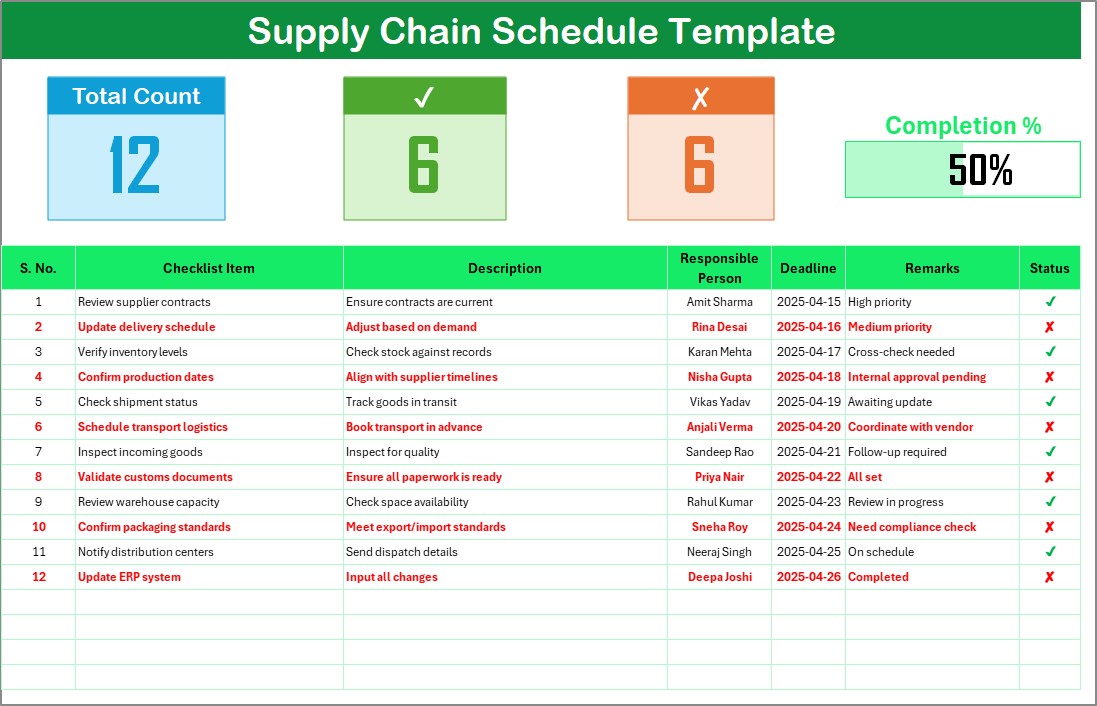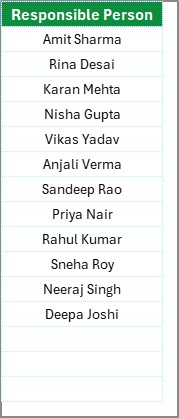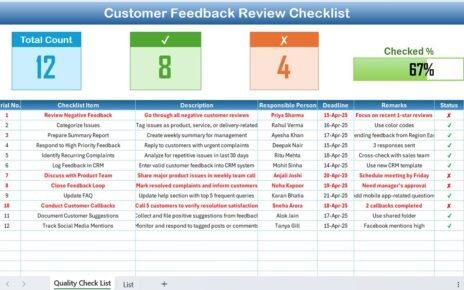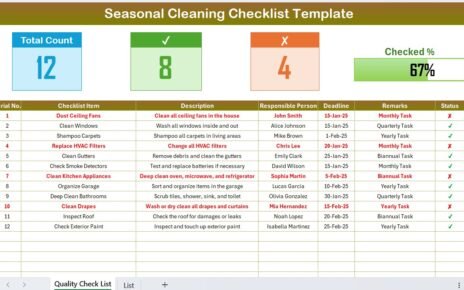In today’s fast-moving global economy, managing a supply chain efficiently is not just important—it’s critical. Whether you run a manufacturing company, a retail chain, or a logistics firm, maintaining a smooth flow from suppliers to customers requires precision, communication, and excellent scheduling.
That’s why we created the Supply Chain Schedule Checklist in Excel—a powerful, ready-to-use tool that helps you track every crucial task from start to finish. In this guide, we’ll walk you through how this checklist works, how to use it effectively, and most importantly, how it can transform your operations with better planning and accountability.
Click to Purchases Supply Chain Schedule in Excel
What is a Supply Chain Schedule Checklist?
A Supply Chain Schedule Checklist is a structured document that outlines the key tasks required to manage the supply chain effectively. It typically includes:
- Procurement activities
- Logistics arrangements
- Documentation checks
- Production timelines
- Warehouse planning
- System updates
Using a checklist not only prevents tasks from being overlooked but also provides visibility across departments.
Why Use Excel for a Supply Chain Checklist?
You might be wondering—why Excel?
Well, Excel remains one of the most versatile tools for business operations, especially when it comes to checklist management. Here’s why:
- Easy to customize: You can modify it as per your operations.
- Data-driven visuals: Add charts, progress bars, or KPIs easily.
- Collaborative: Share with team members or departments via cloud.
- Cost-effective: No extra software investment required.
And with conditional formatting, formulas, and drop-downs, Excel can do far more than just list items—it can become a visual project management tool.
Overview of the Supply Chain Schedule Checklist Template in Excel
We have designed a ready-to-use checklist template tailored to common supply chain activities. It has two core worksheets:
Supply Chain Schedule Checklist (Main Sheet)

This is your main working sheet. Here’s what you’ll find:
- ✅ Top Summary Cards
These dynamic cards show:- Total Count of checklist items
- ✔ Checked Count (completed tasks)
- ✘ Crossed Count (pending tasks)
- Progress Bar – visualizing percentage completion
- ✅ Checklist Table
The core table has the following columns:- Serial No.
- Checklist Item
- Description
- Responsible Person
- Deadline
- Remarks
- Status (✔ or ✘)
You only need to change the status manually based on task progress. The rest of the dashboard updates automatically using formulas and conditional formatting.
Click to Purchases Supply Chain Schedule in Excel
List Sheet (Support Sheet)

This sheet is used for drop-down management.
- It contains a list of Responsible Persons so you can easily assign tasks using a drop-down menu in the main table.
- This ensures data consistency, especially when tracking team responsibilities.
Advantages of Using the Supply Chain Schedule Checklist
Using this Excel-based checklist has many benefits for businesses of all sizes:
✅ Boosts Visibility
You’ll see what’s done, what’s pending, and who’s responsible—all in one place.
✅ Reduces Delays
Tasks with upcoming deadlines are clearly visible, which reduces last-minute chaos.
✅ Enhances Accountability
Assigning tasks to team members and tracking their progress fosters responsibility.
✅ Improves Collaboration
Your logistics, procurement, warehouse, and production teams stay on the same page.
✅ Easy to Update
Anyone with basic Excel skills can update statuses or add more items.
How to Use the Checklist Template – Step-by-Step
Step 1: Download the Template
Start by downloading the checklist from the provided link.
Step 2: Assign Tasks
Fill in or update each row with specific checklist items, deadlines, and responsible persons.
Step 3: Track Status
Update the Status column with ✔ or ✘ depending on whether the task is completed or not.
Step 4: Monitor the Dashboard
The top cards and progress bar will automatically reflect changes. This gives an instant snapshot of your progress.
Step 5: Review and Act
Regularly review pending tasks and follow up with team members to resolve bottlenecks.
Best Practices for Managing Supply Chain Schedules in Excel
To get the most out of this checklist, follow these best practices:
🔄 Keep it Updated Daily
Make it a part of your daily routine to update the checklist—consistency is key.
👥 Assign One Owner per Task
Avoid confusion by assigning one clear responsible person per task.
🎯 Set Realistic Deadlines
Ensure deadlines reflect actual business timelines to avoid missed deliveries or penalties.
📬 Automate Reminders
Use Excel in combination with Outlook to set follow-up reminders for upcoming deadlines.
🛠️ Don’t Overcomplicate
Keep descriptions and checklist items clear and to the point—simplicity wins.
📈 Use Case Scenarios
Wondering who can use this tool? Here are a few use cases:
- 🏭 Manufacturers planning their weekly inbound and outbound shipments
- 📦 Warehouse managers checking for stock movement and delivery timelines
- 🚛 Logistics coordinators tracking shipment, customs, and transport
- 🛒 Retailers managing seasonal product schedules with vendors
- 💻 ERP administrators needing to update internal systems timely
🔄 Opportunities for Improvement
No tool is perfect, and here are a few enhancements you can consider:
- ⏰ Add a countdown timer using Excel formulas for deadline tracking
- 📧 Integrate with email alerts via VBA for due reminders
- 🧾 Link to external documents like contracts or shipment receipts
- 📊 Connect to Power BI for real-time visual dashboards
- 📁 Add a comments column for collaborative updates or notes
Conclusion
If you’re looking for a simple yet powerful way to manage your supply chain activities, the Supply Chain Schedule Checklist in Excel is your answer. It offers full visibility, team accountability, and an easy-to-understand interface that even non-tech users can work with. In just a few clicks a day, you can save hours of back-and-forth emails, prevent shipment delays, and streamline your entire logistics planning process.
So, don’t let chaos creep into your supply chain—take control with this easy-to-use Excel checklist!
Frequently Asked Questions (FAQs)
Is this checklist suitable for small businesses?
Absolutely! It is perfect for businesses of all sizes, from startups to enterprises.
Can I add more rows or columns to the template?
Yes, you can add or delete rows, change headers, or even insert new columns based on your operational needs.
What if I don’t know Excel formulas?
Don’t worry! The template comes pre-filled with formulas. Just update the status column and everything updates automatically.
Can this be used for export/import planning?
Yes. It includes fields for customs documents, transport booking, and packaging compliance, making it ideal for international logistics.
How do I track multiple teams or departments?
Use filters or conditional formatting in the Responsible Person column to track department-wise progress.
Click to Purchases Supply Chain Schedule in Excel
Visit our YouTube channel to learn step-by-step video tutorials



